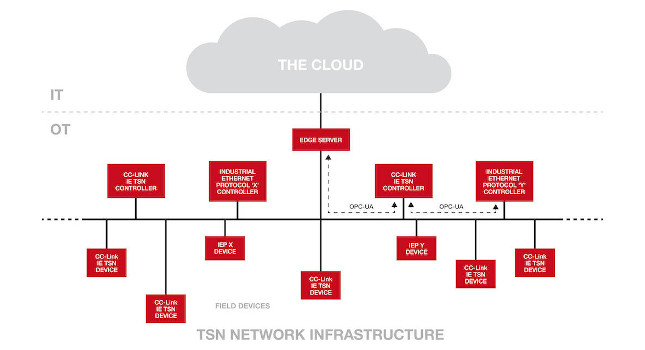Digital manufacturing needs TSN
Time-sensitive networking (TSN) can help reshape industrial communications and factory operations and futureproof digital manufacturing.
Time-sensitive networking (TSN) is an innovative technology defined by IEEE 802.1 standards that resides at layer 2 (data link) of the Open System Interconnection (OSI) reference model for communications. It makes Ethernet deterministic by design, thus improving data transfer accuracy and reliability.
More precisely, two key pillars of TSN and its innovative deterministic capabilities are the IEEE 802.1AS – “Timing and Synchronization for Time-Sensitive Applications” and IEEE 802.1Qbv – “Enhancements for Scheduled Traffic” sub-standards. These provide the foundation to offer deterministic performance.
A closer look at TSN standards
The first substandard, IEEE 802.1AS, is based originally on IEEE 1588 – “Standard for a Precision Clock Synchronization Protocol for Networked Measurement and Control Systems.” It supports the synchronization of all devices within a network with extreme accuracy by making sure that all network devices are operating according to a common time system. This time synchronization is handled by a network clock master, also known as a ‘Grandmaster’. This sends time information in the format of Ethernet packets to each node and to the “Time-Aware System” within the network.
As a result, all devices operate according to the same clock, minimizing the likelihood of time drifts (jitter) that may lead to delays in data transfer. This is substantially different to what occurs on standard Ethernet networks, where each device has its own internal clock and the accumulation of time errors can lead to unwanted jitter.
IEEE 802.1Qbv leverages the synchronized environment created by IEEE 802.1AS to set up effective traffic scheduling systems. This sub-standard provides network switches with so-called time-aware shapers (TASs) to transport time critical data, such as motion and control information. A prioritization of urgent and regular data is therefore possible with TASs, as periodic time windows (slots) are created based on time division multiple access (TDMA) models. During these intervals, only scheduled or reserved time- or mission-critical data is transmitted, without any interference.
In effect, since all TASs and network devices are synchronized, every node is aware of when priority data may be sent and processed. Consequently, sending and receiving times will be scheduled in the traffic definitions of the data packages.

By using IEEE 802.1AS, all devices on the network have a shared time reference. This provides deterministic communications by controlling latency and jitter. Hence traffic travels across the network in a predictable manner. Courtesy: CC-Link
Determinism supports data convergence
The TSN standards can avoid possible data loss by preventing network overload. In addition, traffic planning and the resulting determinism help companies to merge multiple types of traffic on one single network. For example, it is not only possible to combine I/O and motion control as well as safety communications without compromising performance. In fact, companies can also integrate other Ethernet traffic from cameras, barcode readers and printers, as well as other Ethernet protocols onto the same network. Companies can also significantly reduce their capital expenditure (CAPEX) by simplifying the network architectures and making better use of their available network bandwidth. Simplified and clearly structured network architectures can reduce possible downtimes by streamlining the identification of errors and their elimination.
In addition, it is possible to use a more flexible infrastructure. With this, devices can easily be added or removed from the network as well as reconfigured while supporting different configuration philosophies. In addition, the transparency and convergence offered by TSN technology can help different parts of the company to access relevant data at different levels. This can have an extremely positive impact on a business’ productivity.
Convergence is at the core of data-driven manufacturing
Enhanced process transparency and productivity can improve even further, as companies can utilize the capabilities of TSN to converge their information technology (IT) and operational technology (OT) worlds. Digital transformation strategies provide data-driven insights that can utilized to optimize key operations.
The data transparency and convergence of TSN enables businesses to connect IT and OT to extract more data from industrial processes and analyze it by means of increasingly accurate and smart predictive models to gather meaningful knowledge on factory floor operations. This in-depth understanding can then be leveraged to improve performance, productivity, efficiency as well as end product quality.

TSN delivers the necessary process transparency to end users by converging the various aspects of the OT and IT worlds. Courtesy: CC-Link
Essential to create successful Industrial Internet of Things (IIoT) applications, merging IT and OT is particularly important in North America, which has also been an early adopter of IIoT and gradually emerged as a hub of innovation. In effect, the region currently dominates the global IIoT market. To remain competitive, market players should therefore begin to support TSN.
Ultimately, TSN can support the creation of competitive and future-proof connected industries that support digital manufacturing applications. Even more, the technology is well equipped to offer compatibility to new, potentially advantageous innovations, such as 5G. Therefore, companies should look at implementing TSN within their facilities now to get ready for the future of industrial communications while also addressing current needs.
– Edited by Chris Vavra, web content manager, Control Engineering, CFE Media and Technology, cvavra@cfemedia.com.
Do you have experience and expertise with the topics mentioned in this content? You should consider contributing to our CFE Media editorial team and getting the recognition you and your company deserve. Click here to start this process.



